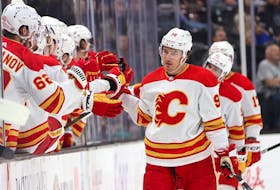
The pre-Herder years - 1924-1934
Before 1924, hockey in the Corner Brook area was largely an informal winter activity. In St. John's, the Newfoundland capital, the sport had been an organized one for roughly 30 years, but in the Bay of Islands hockey was still a novelty. If there were games, they were played on the frozen bay and were more recreation than competition.
Between the years 1901 and 1923, the weekly newspaper for the Bay of Islands, The Western Star, briefly covered the sport on several occasions but only for games which took place in the capital city. Oftentimes, open air rinks were constructed on the bay to facilitate recreational skaters but there is no mention of hockey games taking place. The most popular competitive winter sport at this time was ice boat racing.
All of this changed suddenly with the construction of the pulp and paper mill and the population surge which accompanied it. Many of the new mill employees came from central or eastern Newfoundland and Canada, and some considered hockey an integral part of winter itself. In late 1923, while the mill and surrounding Townsite were still under construction, several employees sought and obtained permission from the Newfoundland Power and Paper Company to make a rink at the Number 2 Warehouse.
A Western Star article from Jan. 9, 1924, says, "A splendid sheet of ice has been obtained, and hockey teams are being formed."
Although there were to be numerous alterations to the structure of the Corner Brook leagues in the following decades, hockey was to remain a permanent, and organized fixture of winter life in the mill town on the Humber.
Several games were played in 1924, but not in an actual league. The first reported game at the rink was between hastily assembled teams from Corner Brook and Deer Lake. Unfortunately, no score was mentioned in The Western Star. Near the end of January, Staff Houses 51 and 52 squared off. A large crowd was in attendance, including people from the neighboring community of Curling. The turnout was impressive considering that the rink was reportedly hard to find, lacked adequate seating, and was cold. The victor of the first inter-mill contest was Staff House 51 by a score of 3 to 2. A couple of weeks later, Corner Brook played Curling, but no score was reported in the local paper, most likely due to the newspaper staff's relative inexperience at covering sporting events.
That same year the Town Construction Sports and Social Committee was formed in order to arrange Townsite's various leisure activities. It was the original committee from which sprang the Corner Brook Athletic Association of later years. This dedicated group subsequently would be responsible for regulating the league, resolving disputes, fund raising, and setting up games with teams from other areas.
The following year, 1925, saw the first organized hockey league in Corner Brook. The players for the first league were drawn from mill employees and the teams were labeled accordingly: the Accounts were office staff, the All-Stars were culled from other departments at the mill, the Electrics were electricians, and Townsite Construction were, of course, employed as construction workers on the new town. In the short season which followed, the All Stars emerged as the top team, the first champions of the Corner Brook League, and the first to win the Stadler Cup. The Stadler Cup was named after John Stadler, the general manager of Newfoundland Power and Paper, and was donated in late 1925. In subsequent seasons it became emblematic of hockey supremacy in Corner Brook.
Spectators in 1925 witnessed the first international hockey games played in Corner Brook. It was a two-game series pitting Team Newfoundland against the likewise broadly- named Team Canada. The Canadians were not a visiting team however. Both groups were comprised of mill employees.
Newfoundland won the first game by a score of 4 to 2, but lost to Canada in game two. The average attendance of both games was 450 people - no small feat considering the town was still in its infancy.
In 1926, the people of Corner Brook enjoyed the second year of league hockey in a new skating rink. Originally, the plans for Townsite included a rink but the Newfoundland Power and Paper Company was experiencing financial difficulties by this date so they had to improvise. The building that would house Corner Brook hockey for the next three decades, until the construction of Humber Gardens in 1955, was originally a building from Deer Lake used in the construction of pipe lines to the power plant. However, it was undoubtedly an improvement over of the No. 2 Warehouse.
There were only three teams in the 1926 season: the Electrics did not return to competition, the Accounts were renamed the Head Office, Townsite Construction was replaced by the Papermakers, and the previous year's champions, the All Stars. In the nine game season that followed, the Papermakers were the winners and received the Stadler Cup for their efforts. The average attendance for the games was somewhere around 350 people. There was also a secondary league that year comprised of teams like the Engineering Department and women's hockey although the weekly newspaper does not give much detail on either.
Due to the mild conditions in early January 1927 the start of the season was somewhat delayed, but by the end of the month the Accounts (Head Office), Papermakers, and All Stars were back at it again. Once again the Papermakers were victorious, securing the Stadler Cup for the second year in a row.
A team of Corner Brook's best also played teams from Sydney and Grand Falls. M. G. Basha was the promoter of the Corner Brook/Sydney series which took place in Corner Brook on Feb. 7, 9 and 10th. The average attendance was 500 people. Sydney was the only team to pull out a win and they took the Basha Cup back to Nova Scotia.
Grand Falls was not as lucky. The first three games for the Tuma Cup, named after Simon Tuma, were played in Corner Brook and the home team won all three. They also went on to win 2 of the next 3 in Grand Falls. However, the train trip to the rival paper town may have proven more difficult for the Corner Brook team than the series. A reporter with The Western Star who followed the team to Grand Falls related how the normally seven-hour train ride turned into 21 hours when the train got stuck in Deer Lake overnight. The majority of players had a horrible time sleeping due to the lack of space and the snoring of one of their teammates. As the sports writer says, "One can hear now the loud snoring of that old veteran "Sharkey" (Marchildon) as the temperature gradually ascended, and finally drove the occupants out of the baggage car."
After a sleepless night, the team finally arrived at Grand Falls five o'clock the next evening, just two hours before game four of the series was scheduled to begin.
The rink was home to several other hockey games during 1927. Corner Brook defeated Curling in what most likely was the area's first recognized Junior Hockey match up. There was also a match between two non-league teams: Goodyear and Petries.
Finally, there was more women's hockey, but in this instance The Western Star provided better coverage. The game was between Mrs. Ledrew's and Mrs. Dunphy's teams. The contest was mostly penalty free, but, as the reporter said, "Tina Garcin nearly laid Grace (Fisher or Ledrew) out once though, and the referee had to put them in the cooler for a minute or two." Apart from this minor squabble, the game was largely one-sided. Mrs. Ledrew's team won 6-0. This was the final game of 1927.
The first contest to excite hockey fans during the 1928 season was the mid-January series between Corner Brook and the St. John's Guards. Corner Brook players had never faced off against a team from the capital. A. E. Hickman of St. John's provided the trophy for the series. Although both teams fought hard, the Guards prevailed, taking 2 of the 3 games at the Corner Brook rink. However, in the Tuma Cup series between Corner Brook and Grand Falls, the former were victorious again. The boys from Corner Brook won 2 of the 3 games at home and 1 of 2 in Grand Falls.
In Senior League play, the All Stars, Papermakers, and Head Office returned once more to vie for the Stadler Cup. Ultimately, the Head Office team were named champions, foiling the Papermakers' attempt at three Stadler Cups in a row. Also, in the previously unmentioned Intermediate League, the Mechanics came out on top. Finally, 1928 was the first year that a championship was awarded for Junior, or high school, hockey. There had been scattered matches in previous years, such as the aforementioned game between the Public School and Curling, but in 1928 the mill company donated hockey gear to both the Public School and St. Henry's, and the now well-equipped teams began what was to become a longstanding rivalry. The first Junior championship went to the Public School.
The following year, 1929, St. Henry's Catholic School was named Corner Brook Junior Hockey champions. In the Intermediate League, there were four teams: the Mechanics, Maroons, Corner Brook, and Curling. Curiously enough, The Western Star listed the Intermediate champions of 1928 while neglecting to mention their competition, and alternately listed the four teams in 1929 without naming the winners.
The Corner Brook Hockey Team in 1929. From left (front row) are Karl Trapnell, Fergy Ferguson, Alex Collins, Allan Curnew; (centre) Andy Cluston, Ron Martin, Freddy Mills, Bill Cossitt, Steve Read and Sharkey Marchildon; (back) Albert Bergeron, Harry Brown, Simon Tuma (trophy donor), Carl Jentz and Cabot Fitzgerald.
Two Senior teams were replaced in 1929. The All Stars, Corner Brook's first champions, gave way to the Knights of Columbus, and the Papermakers, who had captured two Stadler Cups, were renamed the International Mill team. Head Office rounded out the league and, for the second year in a row, won the Stadler. It would also prove to be the last year, until 1935, that the league was structured along mill department lines. The Corner Brook team, for the third year in a row, bested Grand Falls in the home and home Tuma Cup series.
The documentary record for the 1930 season is sketchy. Although The Western Star lists team line-ups and statistics it only goes as far as Feb. 26. Similarly, there is a gap in Finn and Murphy's "The History of Hockey in Corner Brook" from 1929-1934. It is clear that the structure of Senior Hockey was changed at this time though. In order to provide a more stable and competitive league a territorial structure was adopted. For the next several years the teams came from different areas of Corner Brook: the Terra Novas from Townsite East Valley, the Crescents from Townsite West Valley, the Victorias from Humbermouth, and the Wanderers from the West Side. It is not certain at this point which team was victorious that season, and though the newspaper includes a roster of the Corner Brook team which was to play Grand Falls, there is no mention of the outcome.
We can be sure however, that hockey in Corner Brook remained a steady fan favorite. Often there were two or three games in a week and large crowds continued to attend. An excerpt from the Feb. 5 newspaper attests to the excitement of one spectator in particular:
"It is rumoured in Hockey circles today that a new whistle is to be purchased for the use of the referee and the Star suggests that an attempt be made to find one with a note different from the voice of a lady enthusiast who has stopped the play several times lately by her bird-like screams."The coverage of the 1931 hockey season is much more comprehensive. Every week in The Western Star there are detailed accounts of Senior League games, and whenever a Junior or inter-town match took place it is given a thorough analysis as well. Also, the Grand Falls hockey league is covered numerous times throughout the 1931 season. Indeed, the majority of inter-town games that Corner Brook took part in during the early years were against Grand Falls. The "paper town series" was almost an annual occurrence so it makes sense that the people of Corner Brook would be interested in the progress of the rival league. The greater coverage of hockey is one indication of the ever-growing popularity of the sport.
The Victorias were the 1931 champions, but that year the battle for the Stadler Cup took place on and off the ice. In the final game of the season, the Victorias downed the Crescents by a narrow margin and, having secured the best record in the Senior League, were awarded the trophy. However, shortly thereafter the Crescents protested the outcome. They argued that the nets being used were illegal, and that they had scored a goal which had not been counted by the referee.
The matter was handed over to the Corner Brook Sports Association who promptly judged the protest invalid and the Victorias remained league champions. Also in 1931, the St. Bon's team from St. John's won a three game series against Corner Brook. The Public School were victorious in the Junior League.
The following three years seem to have been less eventful. The Western Star continued to cover Senior Hockey but no Junior League champions are mentioned. Moreover, apart from a three game series versus Grand Falls in 1933 (which Corner Brook won) inter-town match ups are not reported. The Crescents were Senior champions of the 1932 season and the Victorias won in 1933. The recipients of the Stadler Cup are not listed for the 1934 season, but the returning Papermakers team are credited with winning the Tie Cup.
In 1935, the Herder Memorial Trophy was competed for for the first time. After only 10 years of organized competition, Corner Brook won the series against the St. John's Guards and received the honor of being named the island's first overall champions - the best team in Newfoundland hockey.
Most importantly, however, all but one of the members of the team were local boys.
When the sport began in Corner Brook most of the players were from away, but a decade later the Junior League had helped produce fine local talent. The Juniors of the late 1920s and early 1930s were the Seniors who captured the Herder, so it was truly a Corner Brook victory.
(Continued next week)
The history of hockey in Corner Brook, researched by Neil White for the
Newfoundland and Labrador Hockey Hall of Fame and covering the period from
the 1920s up to 1990, will appear on this website over the next 22 weeks.
The series of articles was first published in The Western Star from December
2000 to May, 2001.
To buy a reprint of this page as it appeared in The Western Star email [email protected].








